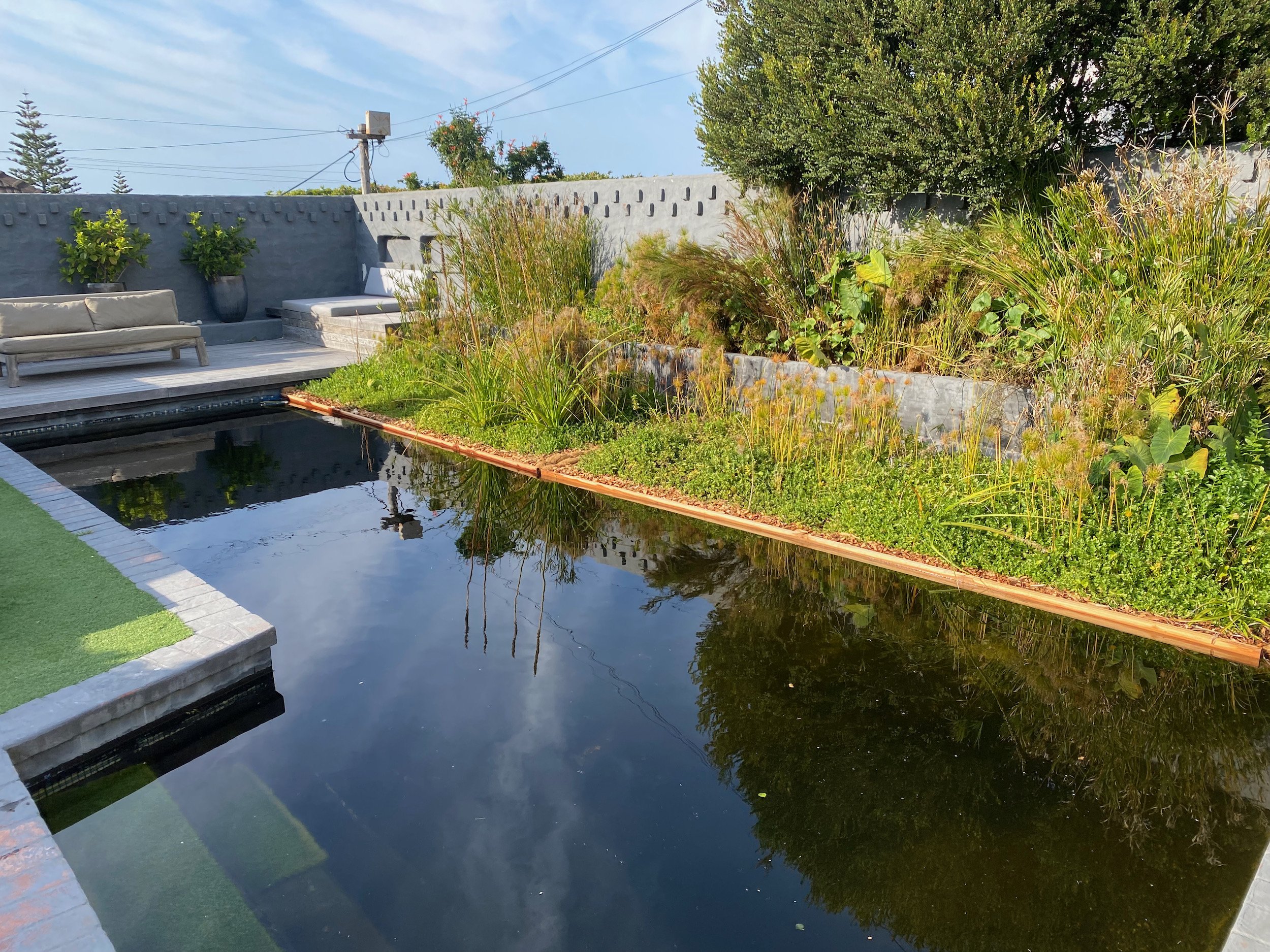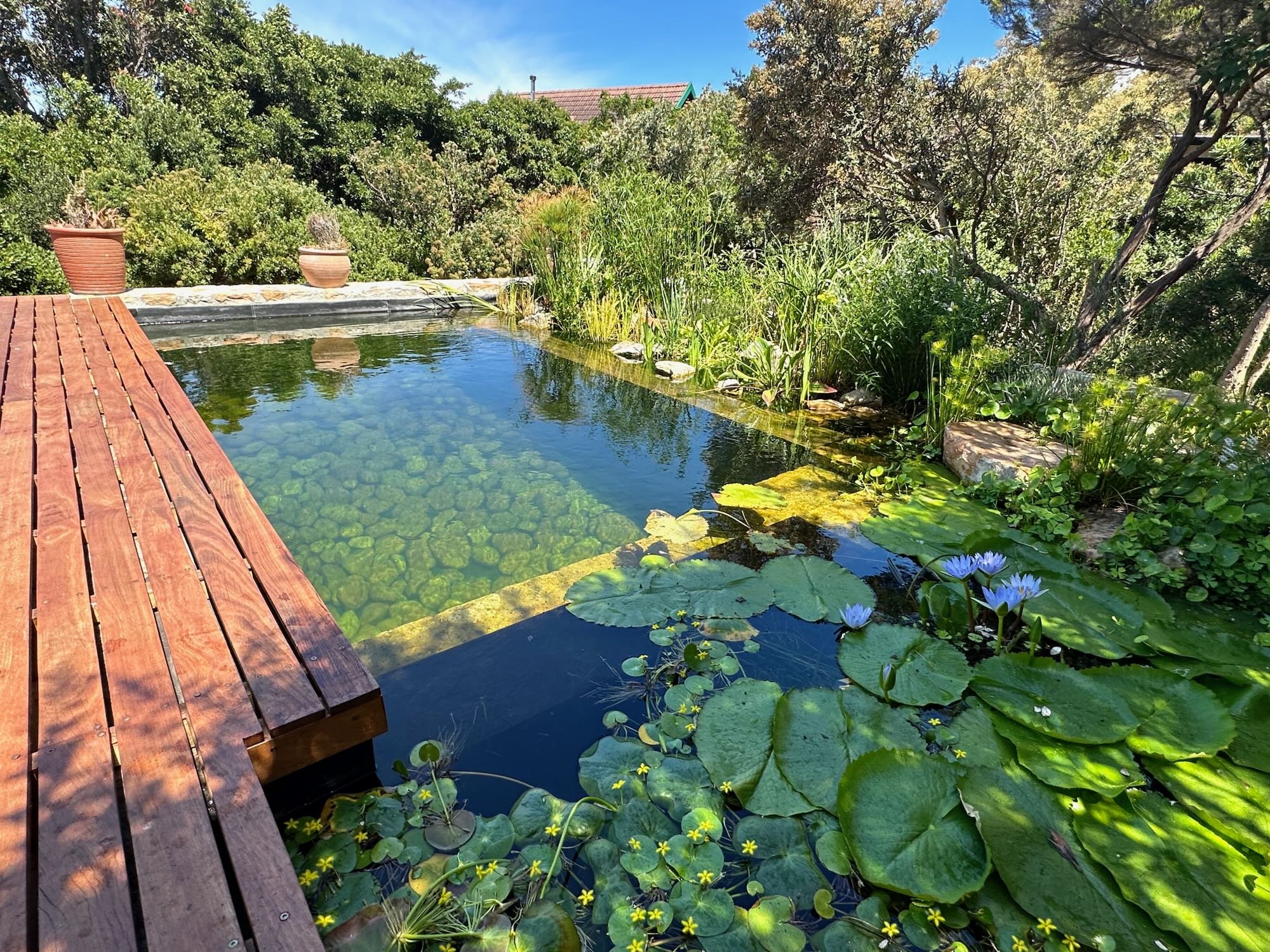Swimming Pools.
As Nature Intended.
NATURAL POOLS CAPE TOWN
What is more inviting than swimming in crystal clear natural water surrounded by plants and water so clean, you can drink it? Once you have tried it, you will find it very hard to go back...
With a chlorinated pool. Time & money are constantly applied to stem the force of nature instead of letting it work for you.
Natural swimming pools are man-made swimming pools that use natural means (plants and microbes) to keep the water clean. Conventionally, pools are kept clean with the use of chlorine (or salt which is essentially chlorine).
If properly designed, natural pools can achieve the same water clarity as conventional pools. They are not swampy ponds but highly technical mini ecosystems that harness the power of nature to biologically keep algae at bay.
Feel the difference
Water is life for human beings, we are 80% water.
We have more beneficial bacteria in and on our bodies than we have human cells. When we swim in chlorinated water we kill all of this life.
Swimming should be an experience of invigoration. One wants to feel renewed and revitalised, drinking in the water as we dive.
So how does it work?
A natural pool uses a wetland to keep the water clean. Just as in nature, water is filtered through soil and plants where a host of microbiota and chemical processes remove nutrients and pathogens. Just like in a mountain stream.
The pool is divided into 2 zones, the swimming zone, and the regeneration zone. The regeneration zone is the wetland where filtration takes place.
In practice, the “soil” is often gravel, or other forms of growing medium (see floating wetlands) but the principle is the same. It is essentially all the plants & beneficial bacteria living in the soil/gravel and plant roots that remove nutrients from the water and without nutrients algae cannot grow. This is what we call biological filtration. In a chlorinated pool, nutrients are never removed, they just keep accumulating which is why you need more and more chlorine over time to keep the water clear.
Swimming ponds
and swimming pools.
Natural Pools can take any shape or form. They can be rectangular and formal or they can be organic in shape like a swimming pond.
The wetland can be placed in the pool, next to the pool (with a division) or even far away from the pool. It is only limited by imagination.
The devil is in the details
Aside from biological filtration, where we are keeping the nutrients in the water low so that algae cannot thrive, there is also mechanical filtration. This is essentially everything else that needs to be removed from the water. Everything that cannot be dissolved and processed out of the water. Leaves, sand, pollen, and insects all need to be kept out of the water and removed. In a conventional pool, you have a sand filter for this which works well BUT it is energy intensive.
Creating a natural pool that is crystal clear requires careful design and consideration harnessing gravity and very low-power pumps to catch all this debris and prevent it from making the pool floor dirty and clogging up the wetland. This also has to be easy to maintain and it needs to work for a long time. Trust me, the last thing you want is a clogged wetland that needs to be pulled apart, cleaned, and rebuilt after 2 or 3 years of use. It is an expensive and messy affair.
We have the experience and design knowledge to ensure that the system is well-designed and will remain functional and hassle-free for at least 10 years. After 10 - 15 years wetlands may or may not need to be cleaned out. This depends on many variables.

Floating Wetlands
Excellent for conversions, floating wetlands create a mini-ecosystem of submerged roots that is the perfect habitat for millions of microbes which then use carbon, excess nutrients, and algae in the water as their food source cleaning and restoring the water body.
FAQs
Is it easy to maintain?
This depends on how it is designed and this indeed depends on the budget. All natural pools will need an annual pruning of the plants. Aside from that the only maintenance required is in the removal of debri. Do you mind having some sludge under your feet? If you do then you can either design for this not to happen (Pristine Natural Pool design) or you can opt to clean the pool every month with a vacuum, pool robot or a kreepy Krawley system (if the design allows). We also offer a maintenance service to handle this for you.
What we can say is that there is no constant measuring of PH, adjusting with chemicals, adding chlorine, adding acid. Natural pools will find there own balance and just do their thing.
What about cost?
A Natural Pool will generally be 1.5x the cost of a conventional pool to build from scratch as you have to create the wetland area. There is however a broad spectrum here. A natural pool very often involves bespoke design, organic shapes and landscaping in the form of boulders, stone cladding etc which obviously can increase the cost. A standard rectangular natural pool with an adjacent wetland will cost far less than a pool made it fit into the landscape like a mountain pool. We have solutions for all budgets though and the best approach is to speak to us.
What about running costs?
A natural pool costs less to run than a conventional pool. The energy consumption is about 30% less (depending on the design of the pool). There is no need for chlorine or other chemicals as well.
Is a natural pool hygienic enough to swim in?
When one hears that a natural pool does not make use of any chemicals to clean the water, the question that often follows is: Can it be safe to swim in? The answer is yes. Natural swimming pools mimic natural processes to remove compounds that could fuel the growth of harmful pathogens and algae. This is how fresh water is cleaned in nature, and natural swimming pools simply mimic this process. We have become used to chemical water treatment since urbanisation brought about water-borne diseases – a result of human waste contaminating water supplies. The chlorine used to clean conventional pool (and drinking) water can’t be thought of as ‘safe’ either. It is a skin and respiratory irritant and may also be a thyroid disruptor, and degrades soil and aquatic ecosystems. The human race has survived for centuries on freshwater resources provided in nature, so there is nothing to fear about a well-maintained natural swimming pool – even if the water is not the bright blue colour you may have become accustomed to.
What about wildlife?
A natural pool will attract birds, dragon flies, frogs, water snails and many other forms of life that are beneficial to the pool ecosystem, your garden and the planet. There is no greater risk of snakes or dangerous wildlife in a natural pool than there would be in say a pristine mountain pool or lake.
Can I convert a natural pool?
You most certainly can. When converting an existing chlorine pool to a natural pool one has 2 main choices. You can either create cost effective floating wetland islands inside the pool OR you construct permanent wetlands inside and/or outside the pool. The latter involves emptying the pool and undergoing construction and re-plumbing.
There are numerous pros and cons to each approach, the main factor being cost.
See for here more info.
What are the downsides?
The only real downside is that the biofilm can make steps and surfaces slightly slippery. There are ways to make this impact minimal and safe but ultimately one has to embrace certain elements of nature in a natural pool.
What about mosquitoes?
Natural pools do not have mosquitoes for a number of reasons. Mosquito larvae need still stagnant water in order to breed. Stagnant water has very low dissolved oxygen, natural pools have good levels of dissolved oxygen from plants, movement and life. Natural pools also have predators that feed on mosquito larvae. Among them are the Notonectidae, popularly known as backswimmers, and the aquatic beetles (Ditiscidae). Larvae of dragonflies and damselflies also hunt mosquito larvae. Constant movement and circulation of the water also prevent the larvae from surviving.



